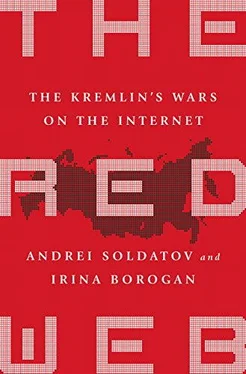“Despite all I wrote here, I’m a patriot!” she said nervously. We both knew in January 2015 her critical words about the way KGB surveillance had been organized had gone out of fashion. Andrei persuaded her to meet him again in the café, hoping to learn more. But she seemed edgy, nervous, and unsettled, only staying long enough to say that the FSB were the best people in the country—and then she was gone.
From other sources we learned somewhat more about the history and scope of SORM. The Twelfth Department had 164 control points arrayed across Moscow. [18] Kalgin’s testimony before the internal investigation commission of the KGB on the events of August 1991, quoted by Andrei Uglanov, “Na Lybyanke posle putsha” [On Lubyanka After the Putsch], Argumenti Nedeli , Moscow, August 17, 2011.
Tape recorders were rolling in district KGB offices, at the central listening point on Varsonofyevsky Lane, and in city telephone stations, where there was room for KGB controllers to hide and do their work. Foreign embassy phone lines were eavesdropped separately. It was called “object control,” which meant that each major embassy had its own surveillance team stationed permanently in nearby buildings, with KGB operatives at the ready in case someone of interest made a call to the embassy and would have to be apprehended before reaching the gates. All in all, until the breakup of the Soviet Union, over nine hundred people served in the Twelfth Department of the KGB in Moscow, with four hundred in Leningrad.
Even so, it wasn’t always that effective. At most, the department could simultaneously wiretap no more than three hundred people. Twenty-four hours of eavesdropping produced between eight and eleven hours of recordings, but one hour of recording required seven hours of transcribing by controllers. The existence of 164 control points was actually a sign of weakness; the KGB needed so many points to direct the traffic by hand because the quality of phone lines was poor, and phone stations in Moscow were of all different types, some dating back to the 1930s. The underground communication lines were awful; in some cases it was physically impossible to get lines connected to the central listening point.
In our investigation we learned that Moscow had extensively borrowed technology and know-how from the feared secret police in East Germany. The Ministry of State Security, known as the Stasi, started working on a national system of wiretapping in East Germany in 1956, at that time called “Systema-A.” [19] The description of Stasi’s wiretapping system is based on information provided by Detlev Vreisleben, an informal historian of Stasi surveillance equipment who works in Stasi archives, for our website Agentura.ru, www.agentura.ru/museum/melton/stasitapping .
By the end of the 1960s Stasi introduced a more efficient, centralized system, known as Centrales Kontrollsystem, or CEKO, which became operational in 1973. It allowed Stasi to eavesdrop simultaneously on four thousand phone numbers, out of a total of 8 million in the country. In the early 1980s the system was updated once again, which became known as CEKO-2, with a very advanced and elaborate system, from the phone lines to tape recorders. CEKO-2 was equipped with tape recorders of the brand “Elektronik,” specially designed for the Stasi, the only security service in the Eastern bloc that enjoyed its own tape recorders. All technical hubs of CEKO-2, in 209 territorial departments of Stasi, were connected with fifteen district departments. In Berlin CEKO-2 had eighteen specially built stations. Central Berlin’s point of CEKO-2 on Frankfurter Allee had four huge communications racks with eleven hundred control points. Special cables were laid from CEKO-2 stations to the switchboard of the nearest phone station, and Stasi “controllers” could listen to conversations directly. Over 70 percent of connections were done on the main switchboard. Such an achievement was possible because the underground communication system in Berlin, built in Hitler’s times, had largely survived the battle for Berlin in 1945.
The KGB learned at the knee of the Stasi officers, envying the technical level of Stasi surveillance. Nikolai Kalyagin, a major-general of the KGB, was in charge of relations with East German secret services for twelve years, first as chief of the KGB station in Bonn and then as chief of the section responsible for cooperation with Stasi. We found his home phone number, and Kalyagin himself answered the call.
Kalyagin told us that there were indeed technical officers of the KGB permanently stationed in Berlin, always interested in German know-how in surveillance. Evidence from our source who served in Germany in the 1980s supported this confirmation.
Kalyagin was helpful, and then Andrei asked him, “Do I understand correctly that the control of phone lines was better organized in Berlin than in Moscow? And that sometimes Germans overtook us in technical means, especially in phone control?”
“Yes, you understand this right,” said Kalyagin.
The Stasi possessed what the KGB so badly wanted—a national system of eavesdropping on communications. SORM was designed to fill this gap, to provide the Soviet KGB with a system built in Moscow and then replicated in all Russian regions. At the time the Soviet Union fell apart, the KGB was working on it but had not fulfilled its goal. After a few years the new Russian secret service, the FSB, took over, and this time new digital technologies helped make the system quite sophisticated.
When, on a summer day of 2014, Andrei walked into the tall building on Butlerova Street in Moscow that houses M9, he saw for the first time the mammoth crossroads for traffic moving between the Russian Internet providers. Nearly a decade ago a single Internet exchange point, MSK-IX, had started in a corner of the twelfth floor of this building. Now it expanded to seven floors, filled with hundreds of communications racks.
With the help of some engineers, Andrei got a pass into the restricted building. Every floor has a special door with a separate code requiring a key to get through. Andrei’s contacts had a key for the eighth floor. The heavy metal door was opened, and Andrei quietly stepped inside a small room, packed with equipment on the racks. One of them had a small black box. It was labeled SORM. It had a few cables and a few lights. Andrei was told that when the small green lamp was illuminated on the box, the FSB guys on the eighth floor have something to do.
As he looked down, Andrei saw the small green lamp winking.
In 1998 and 1999 Levenchuk had done much to bring SORM to public attention, but when none of the big ISPs resisted, he felt deflated and discouraged. In 1999 Egorova and Levenchuk got married. He gave up his involvement in politics. Levenchuk had lost his battle against SORM, and he lost it to a new director of the FSB. His name was Vladimir Putin.
CHAPTER 5
The Coming of Putin
In the aftermath of the Russian economic crisis of 1998 President Yeltsin appointed three prime ministers in succession. None were economists, but all were closely tied to the security services. Yevgeny Primakov, who had been head of the foreign intelligence service, served as prime minister from September 11, 1998, to May 12, 1999. He was replaced by Sergei Stepashin, who had been director of the FSB in 1995. Then, on August 9, Yeltsin appointed Vladimir Putin, who had served as director of the FSB from 1998 to 1999.
By the summer of 1999 Russia was slowly and painfully recovering from the economic crisis, and in September Moscow was shaken by two apartment-building bombings that killed 216 people. [1] On September 9, 1999, shortly after midnight, between six and eight hundred pounds of explosives detonated on the ground floor of an apartment building on Guryanova Street in southeast Moscow. The nine-story building was destroyed, killing 94 people and injuring 249. On September 13 a large bomb exploded at 5 a.m. in the basement of an apartment block on Kashirskoye Highway in southern Moscow: 118 people died, and 200 injured.
Chechen terrorists were blamed, and soon a new military offensive was launched in Chechnya in retaliation. But Yeltsin was not afraid of riots or terrorists; he and his entourage only feared his former close allies. A powerful political figure, Moscow Mayor Yuri Luzhkov, made a bid for the Kremlin. He also launched an attack on Yeltsin’s family, accusing them of corruption. Yeltsin’s team watched anxiously when Primakov joined with Luzhkov, and together they formed a new political party called Fatherland, seeking seats in parliament in the election of December 1999 and, it was assumed, the presidency in the contest set for March 2000. Yeltsin’s term was to end in a few months, and his safety and that of his family was under question.
Читать дальше












